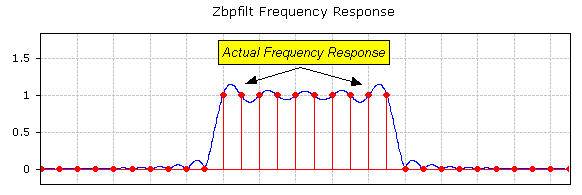
DADiSP Online Help
Click here to see this page in full context

DADiSP Worksheet Functions > Function Categories > Fourier Transforms and Signal Processing > ZBPFILT
Performs band pass filtering by zeroing the FFT values.
ZBPFILT(series, fp1, fp2, mask)
|
series |
- |
Input series to filter. |
|
fs1 |
- |
Optional. A real, the first band pass cutoff frequency. Defaults to rate(series)/10. |
|
fs2 |
- |
Optional. A real, the second band pass cutoff frequency. Defaults to |
|
mask |
- |
Optional. An integer, return the frequency domain mask only. Defaults to 0, return processed input. |
A series, the band pass filtered output.
W1: gsin(1000, 0.001, 10) + gsin(1000, 0.001, 20) + gsin(1000, 0.001, 30) + gsin(1000, 0.001, 40)
W2: zbpfilt(w1, 15, 35)
W1 contains the sum of 10 Hz, 20 Hz, 30 Hz and 40 Hz sinewaves.
W2 filters out the 10 Hz and 40 Hz components leaving a series consisting of 20 Hz and 30 Hz sine components.
ZBPFILT performs band pass filtering by zeroing out the stop band components of the FFT of the input. FFT zeroing is a crude but fast filtering operation. However, the pass band and transition edge of the equivalent filter will exhibit significant ripple.

For a flatter response, use traditional filter design methods such as those offered by DADiSP/Filters.
If fs1 < 0 or fs2 < 0, no filtering is performed.
If mask == 1, the frequency domain binary mask used to zero out the stop band frequencies is returned.
See ZBSFILT for a band stop filter.